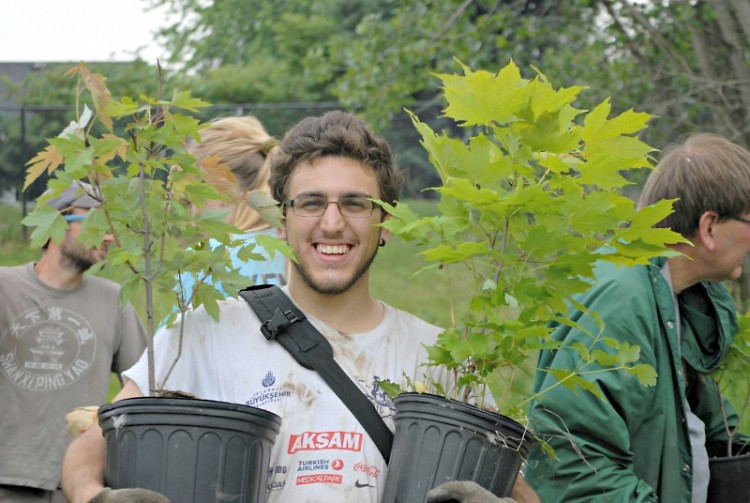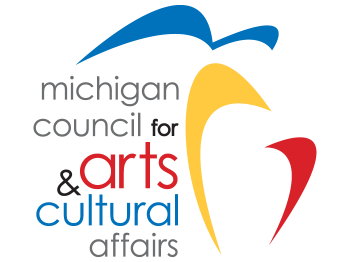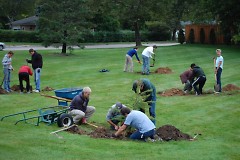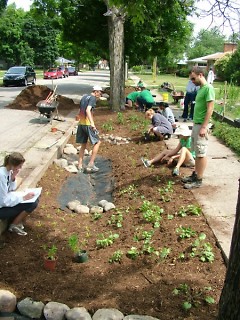Because the way we live on the land affects the quality of our waters, even if we can't see a creek from our house, the way we take care of our yards is imortant.
A main focus of Plaster Creek Stewards is to help residents become aware of the state of the creek that drains their watershed, which in our case is the highly degraded Plaster Creek. Usually when residents hear about Plaster Creek’s dangerous levels of E. coli, high loads of nutrients and sediment, and its loss of aquatic biodiversity, they become concerned and want to know what they can do to help. We have yet to encounter someone who actually wants a polluted stream running through their neighborhood! The challenge is to build awareness and provide practical options for what watershed residents can do.
To build awareness it is important to realize that Plaster Creek’s problems are all directly connected to the water that runs off land surfaces in the watershed (essentially an area of land that all drains to a common waterway). Therefore, the way we are living on the land affects the quality of the water that drains our land. The reason why many urban waterways, including Plaster Creek, are so degraded today, is because in the past people have failed to appreciate the importance of this land-water connection.
Once people become aware and want to become part of the solution, we encourage them to carefully consider the small parcel of nature over which they have the most control - their very own yard. So how does a resident go about caring for their yard in ways that reflect their concern for their watershed?
A good place to start is to consider the stormwater footprint of a yard. When it rains, where does the water go? How much actually leaves the property into the nearest storm drain and what possible contaminants does it pick up on its way?
Here is a list of potential remedies – things to do to show your love for local waters:
1. Slow it down and soak the rain soak in. Try to retain as much rain on your property as you can. Rain gardens are great ways to capture stormwater, and decrease the amount that makes it off your yard and into your local creek. Rain barrels are another great way to capture rainfall, and then later use it to water your garden or lawn. Here is a resource that helps you learn more about rain gardens and what plants work well in them.
2. Add native shrubs. Introducing some native shrubs to your landscape, or even replacing non-native shrubs with native alternatives helps in several ways. Many native Michigan shrubs can tolerate pruning, have lovely flowers, generate fruit for birds, and are largely care-free when planted in the right location. In addition, lots of native shrubs (and some trees too) are essential host plants for Michigan butterflies. Our native butterflies require certain native species for laying their eggs. A great resource that lists the important host and nectar species for all our native butterflies can be found here.
3. Plant more trees, please. Trees are terrific at soaking up rainwater and carbon, holding soil, and supporting biodiversity. Oaks and hickories are terrific trees to plant in sandier soils, Sugar Maple and Red Maple are better for clay soils. Some trees that are known as great hosts for butterflies and also work well in home landscaping include Hackberry, Tulip tree, Redbud, Juneberry, White Pine and White Birch. If you need another reason to plant trees, the City of Grand Rapids is trying to increase its urban tree canopy. You can help! What places in your yard can accommodate a new tree? For information on how to help with this initiative, contact the Urban Forest Project.
4. When fertilizing your lawn, consider using organic fertilizers. Milorganite is one commercially available option. Gardens Alive! is a company in Indiana that sells all kinds of organic options for lawn and garden care. Furthermore, if you compost, compost can be ‘top-dressed’ onto your lawn, raked in, and over-seeded if you like. Compost is great at retaining moisture and it acts as a slow-release fertilizer over time. But remember, even organic fertilizers can become problematic if they get into a creek so always use fertilizers judiciously and never right before a major storm event.
5. Lawn care – It is best to keep your lawn between 2 and 3.75 inches in height. Higher cut lawns are more stress tolerant, help retain soil moisture and do a better job of shading out weeds. This is especially important during the hot summer weeks when crabgrass is on the rise. Also, remember that every power tool invented to help with lawn care was predated by a hand tool that accomplished the same purpose. And many of these hand tools are still great options (push mower, hand edger, broom, rake, hand clippers, etc.). Hand tools provide more exercise for the user and they don’t use fossil fuels. They are also more quiet. Talking with your neighbor while sweeping is much easier to do than when you are using a backpack blower! If your lawn is too large to tend with hand tools, maybe that’s a sign to consider the next question . . .
6. How much lawn does your yard really need? Lawn requires lots of care (chemical inputs, maintenance activities, irrigation) and does not support much biodiversity. Replacing even small areas of lawn with native plants helps to tip this balance in favor of nature. Problem areas that are either too dry or too wet to easily grow healthy grass are prime candidates for a makeover! Check out this site for some helpful ideas.
In the past, cities have been developed with little regard for the rest of the earth. Instead of trying to fit in, most urban developments pretty much impose the human presence on nature. There are significant environmental health and human health costs associated with this approach, costs we are just beginning to understand. But we don’t have to keep having these kinds of impacts; we can make changes.
Those of us who have a yard are de facto governors over a small part of nature. If we govern thoughtfully these small parcels can become blessings to other species with whom we share our spaces and blessings to the nearest waterway that receives the rain coming off our property. Urban creeks don’t have to be hazardous to our health and nature doesn’t have to be something we need to travel outside the city to see. Instead, if we live more carefully within our watersheds, local creeks will be renewed, and nature will be as close as a window with a view out into our yard.
Spring Event
Plaster Creek Stewards will host a Spring Event on this topic Saturday, April 30 from 9:00 a.m. to 12:00 p.m. at the Calvin College Bunker Interpretive Center. Following a brief presentation, several hands-on restoration projects will be available to choose from for those eager to learn by doing and in the process help us improve the creek. For more information click here. RSVP at plastercreekstewards@calvin.edu
The Rapidian, a program of the 501(c)3 nonprofit Community Media Center, relies on the community’s support to help cover the cost of training reporters and publishing content.
We need your help.
If each of our readers and content creators who values this community platform help support its creation and maintenance, The Rapidian can continue to educate and facilitate a conversation around issues for years to come.
Please support The Rapidian and make a contribution today.



